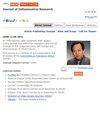Unveiling and Validating the Role of Fatty Acid Metabolism in Ulcerative Colitis
IF 4.2
2区 医学
Q2 IMMUNOLOGY
引用次数: 0
Abstract
Background: Ulcerative colitis (UC) is a debilitating intestinal disorder that imposes a significant burden on those affected. Fatty acid metabolism plays a pivotal role in regulating immune cell function and maintaining internal homeostasis. This study investigates the biological and clinical significance of fatty acid metabolism within the context of UC.Methods: Gene expression profiles from patients with UC and healthy controls were retrieved, enabling the identification of differentially expressed genes (DEGs) specific to UC. These DEGs were then intersected with genes related to fatty acid metabolism, resulting in the identification of differentially expressed fatty acid metabolism-related genes (FAM-DEGs). Machine learning was employed to pinpoint key feature genes from the FAM-DEGs, which were subsequently used to construct a predictive UC model and to uncover molecular subtypes associated with fatty acid metabolism in UC. An animal model of UC was established using 3% dextran sulfate sodium (DSS) administration. Western blot analysis confirmed the expression levels of genes in intestinal tissues.
Results: The machine learning analysis identified three pivotal genes—ACAT1, ACOX2, and HADHB—culminating in a highly predictive nomogram. Consensus cluster analysis further categorized 637 UC samples into two distinct subgroups. The molecular subtypes related to fatty acid metabolism in UC exhibited significant differences in gene expression, biological activities, and enrichment pathways. Immune infiltration analysis highlighted elevated expression of two genes (excluding HADHB) in subtype 1, which corresponded with a marked increase in immune cell infiltration within this subtype. Western blot analysis demonstrated that ACAT1, ACOX2, and HADHB expression levels in the DSS group were significantly reduced, paralleling those observed in the normal group.
Conclusion: This study highlights the critical role of specific fatty acid metabolism-related genes in UC, emphasizing their potential as targets for therapeutic intervention and shedding light on the underlying mechanisms of UC progression.
揭示并验证脂肪酸代谢在溃疡性结肠炎中的作用
背景:溃疡性结肠炎(UC溃疡性结肠炎(UC)是一种使人衰弱的肠道疾病,给患者带来沉重负担。脂肪酸代谢在调节免疫细胞功能和维持体内平衡方面发挥着关键作用。本研究探讨了脂肪酸代谢对 UC 的生物学和临床意义:方法:检索了多发性硬化症患者和健康对照组的基因表达谱,从而确定了多发性硬化症特有的差异表达基因(DEGs)。然后将这些 DEGs 与脂肪酸代谢相关基因交叉,最终确定了脂肪酸代谢相关差异表达基因(FAM-DEGs)。利用机器学习从 FAM-DEGs 中找出关键特征基因,然后利用这些基因构建 UC 预测模型,并发现与 UC 中脂肪酸代谢相关的分子亚型。利用 3% 右旋糖酐硫酸钠(DSS)给药建立了 UC 动物模型。Western印迹分析证实了肠道组织中基因的表达水平:结果:机器学习分析确定了三个关键基因--ACAT1、ACOX2 和 HADHB--最终形成了一个高度预测性的提名图。共识聚类分析进一步将 637 个 UC 样本分为两个不同的亚组。UC 中与脂肪酸代谢相关的分子亚型在基因表达、生物活性和富集途径方面存在显著差异。免疫浸润分析强调了亚型 1 中两个基因(不包括 HADHB)表达的升高,这与该亚型中免疫细胞浸润的明显增加相对应。Western 印迹分析表明,DSS 组的 ACAT1、ACOX2 和 HADHB 表达水平明显降低,与正常组相同:本研究强调了特定脂肪酸代谢相关基因在 UC 中的关键作用,强调了这些基因作为治疗干预靶点的潜力,并揭示了 UC 进展的潜在机制。
本文章由计算机程序翻译,如有差异,请以英文原文为准。
求助全文
约1分钟内获得全文
求助全文
来源期刊

Journal of Inflammation Research
Immunology and Microbiology-Immunology
CiteScore
6.10
自引率
2.20%
发文量
658
审稿时长
16 weeks
期刊介绍:
An international, peer-reviewed, open access, online journal that welcomes laboratory and clinical findings on the molecular basis, cell biology and pharmacology of inflammation.
文献相关原料
| 公司名称 | 产品信息 | 采购帮参考价格 |
|---|
 求助内容:
求助内容: 应助结果提醒方式:
应助结果提醒方式:


